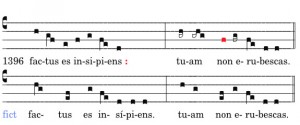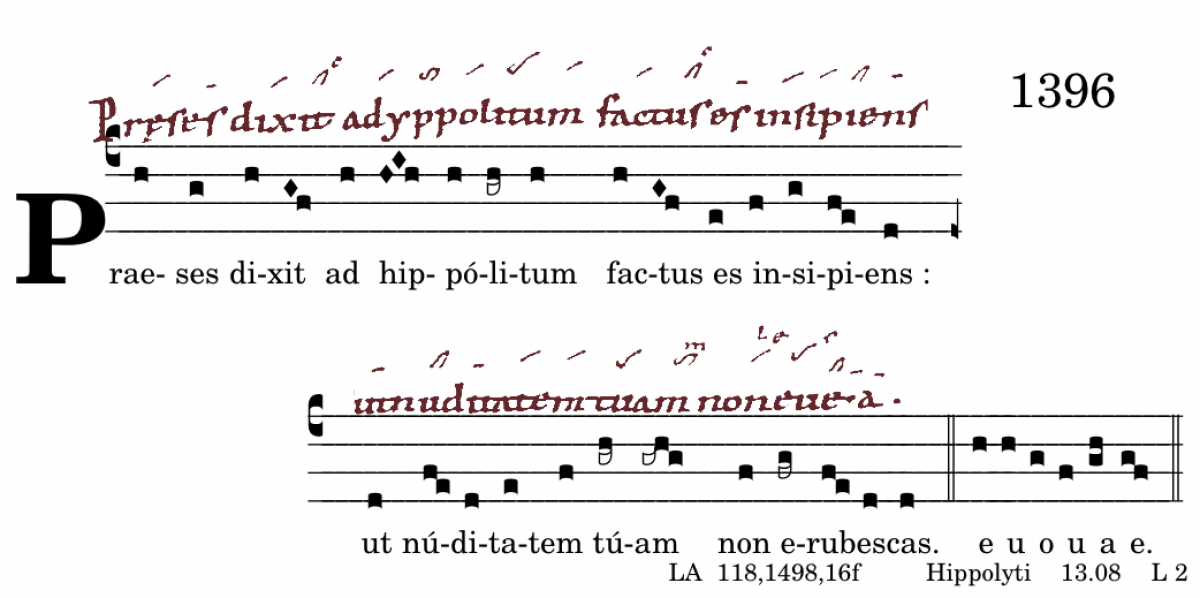Benutzer-Werkzeuge
🔘 IN GR TR AL OF CO xxxxx ✅ 2️⃣ 0️⃣ 3️⃣ 4️⃣ 5️⃣ 6️⃣ 7️⃣ 8️⃣ xxxxx AN RP IV alia
1396 AN Praeses dixit ad hippolytumModus 1
↖️
 Eine sehr eigenwillige Antiphon und trotzdem völlig den Assoziationsregeln entsprechend: Sie steht als zweite in einer Reihe von sechs Laudes-Antiphonen (1395-1400), die fortlaufend aus der vita des Hippolyt erzählen.
Eine sehr eigenwillige Antiphon und trotzdem völlig den Assoziationsregeln entsprechend: Sie steht als zweite in einer Reihe von sechs Laudes-Antiphonen (1395-1400), die fortlaufend aus der vita des Hippolyt erzählen.
Der Komponist liest den Text als zwei selbstständige Sätze, die beide mit 1TER de5 abgeschlossen werden. Der erste Satz schließt mit Doppelpunkt oder Fragezeichen oder Ausrufezeichen, alle drei Bedeutungen sind bei diesen Satz möglich und mitgedacht :„du bist verrückt“. Die zweite Terminatio, beginnend mit Pes und Torculus, die „tuam“ stark hervorheben und abrunden (nicht übertreiben: m=mediocriter!), müsste mit „mi“ fortfahren. Das „fa“ an seiner Stelle deutet die Ratlosigkeit des Kaisers, oder wie immer man die Gefühle des Sprechers nennen will, nahezu perfekt. Das „fa“ und der folgenden kPes sind durch die Buchstaben in der adiastematischen Handschrift H fast zweifelsfrei festgelegt: levare, höher als der Normalfall = fa, kPes unisonisch anschließen =equaliter, das sursum für den zweiten Ton des Pes muss jedenfalls emotional gedeutet werden, könnte aber zusätzlich der Hinweis auf eine 1FML la-fa-re sein. Dafür findet sich kein zusätzlicher Hinweis. Weil 1FML la-fa-re sonst immer mit Pes sol-la beginnt ist das equaliter wohl als Argument gegen diese Übersteigerung zu lesen. Sie wäre vom Sinn des Textes her auch etwas dick aufgetragen. Alle anderen Handschriften, auch MR, schreiben Standardform der 1TER de5.
Der zweite Satz eröffnet mit 2INC cad ad4 und verschmilzt mit der Terminatio.

Diese zweite Laudesantiphon überhaupt, ihr erster Satz beginnt mit einer Melodie, die nur als BIN triv gelesen werden kann! Die Wahl des Binnecentos am Beginn ist wohl in erster Linie der Fortführung der Geschichte aus der ersten Laudesantiphon zu verdanken, alle Incipits des Protus authenticus wären denkbar, keine allerdings so textdeutend wie diese.
1INC Clv verlangt unmttelbar danach die Sinnspitze. Das ist „factus es insipiens“ nicht.
1INC VrgStr und 1INC ad4 sind zu sehr in sich abgeschlossen, verlangen einen Neuanfang, was dem Text auch keinesfalls entspricht.
Ein klassisches BIN triv würde nicht abschließen und ließe offen, wann und ob eine Sinnspitze folgt. Ihre Wirkung wäre traurig spannungslos:
Der Ankläger will den Angeklagten beschämen, das kann nur auf der höchsten Rezitationsebene des Protus authenticus, dem „la“ geschehen. „Práeses díxit“ ist die zweiakzentige Form von MED triv, dann folgt reine Rezitation mit Akzenttorculus auf dem Morphem „híp-po“, der Binnensilben kPes weist das Wort aber als PPO aus; „hippólitum“.
● Der Vorsitzende sagte zu Hippolyt:
Du bist verrückt geworden: daß du wegen deiner Nacktheit nicht errötest.
● The chairman said to Hippolytus:
You have gone mad: that you do not blush because of your nakedness.
 A very unconventional antiphon and yet completely in keeping with the rules of association: it is the second in a series of six Lauds antiphons (1395-1400), which tell the story of Hippolytus' life in a continuous sequence.
A very unconventional antiphon and yet completely in keeping with the rules of association: it is the second in a series of six Lauds antiphons (1395-1400), which tell the story of Hippolytus' life in a continuous sequence.
The composer reads the text as two independent movements, both of which end with 1TER de5. The first movement ends with a colon or a question mark or an exclamation mark, all three meanings are possible in this movement and are included: „you are mad“. The second terminatio, beginning with pes and torculus, which strongly emphasise and round off „tuam“ (don't exaggerate: m=mediocriter!), should continue with „mi“. The „fa“ in its place indicates the perplexity of the emperor, or whatever you want to call the speaker's feelings, almost perfectly. The „fa“ and the following kPes are established almost beyond doubt by the letters in the adiastematic handwriting H: levare, higher than the normal case = fa, kPes following in unison =equaliter, the sursum for the second tone of the pes must in any case be interpreted emotionally, but could additionally be the indication of a 1FML la-fa-re. There is no additional indication of this. Because 1FML la-fa-re otherwise always begins with pes sol-la, the equaliter should probably be read as an argument against this exaggeration. In terms of the meaning of the text, it would also be a bit thick. All other manuscripts, including MR, write the standard form of 1TER de5.
The second sentence opens with 2INC cad ad4 and merges with the terminatio.

This second ever lauds antiphon, its first movement begins with a melody that can only be read as BIN triv! The choice of the binnecento at the beginning is probably primarily due to the continuation of the story from the first Lauds antiphon; all the incipits of the Protus authenticus would be conceivable, but none of them are as textually clear as this one.
1INC Clv demands the point of meaning immediately afterwards. This is not „factus es insipiens“.
1INC VrgStr and 1INC ad4 are too self-contained, demanding a new beginning, which does not correspond to the text at all.
A classical BIN triv would not conclude and would leave open when and whether a climax would follow. Its effect would be sadly lacking in tension:
The accuser wants to shame the accused, this can only happen at the highest level of recitation of the protus authenticus, the „la“. „Práeses díxit“ is the two-accent form of MED triv, followed by pure recitation with an accentual torculus on the morpheme „híp-po“, but the internal syllable kPes identifies the word as PPO; „hippólitum“.

